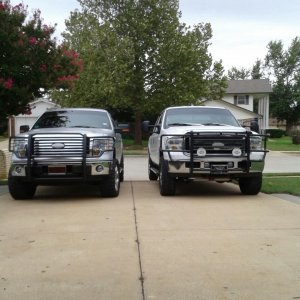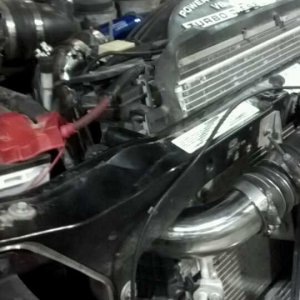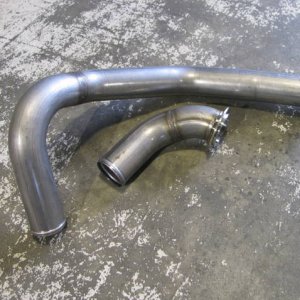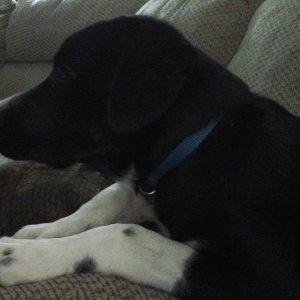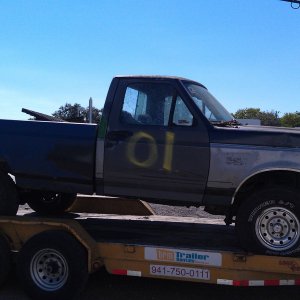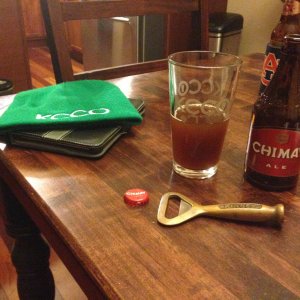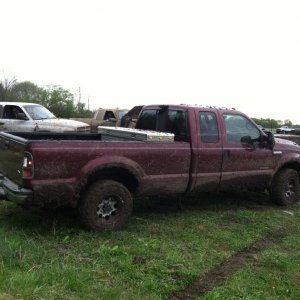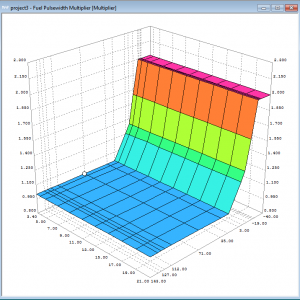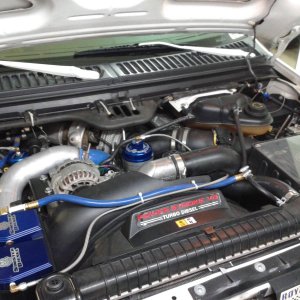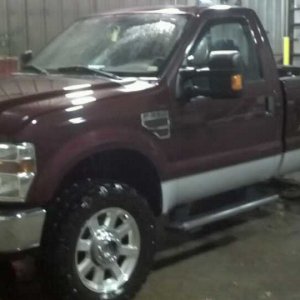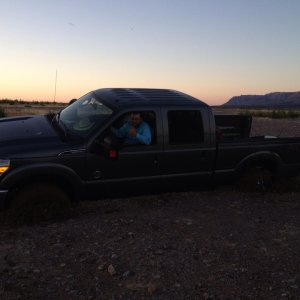colo_dually
New member
- Joined
- May 18, 2012
- Messages
- 154
- Reaction score
- 0
I wrote this over a year ago on another Forum, thought it would be a good addition here as well.
Background: I had my EGR Cooler fail on my 2007 F350, back in January of 2011. The write up you are about to read is a copulation of fixing my issue and months of researching and wanting to get all of these problems corrected. I wanted a bullet-proofing option that would fit into my budget, and keep the truck on the road for as long as possible.
Run down of the events: Basically it came down to me neglecting my truck, and not fully understanding the nature of the 6.0L’s pit falls. I had a clogged up oil cooler, and a 19* ECT/EOT delta was noted in my dealership troubleshooting efforts. I had a failed EGR cooler that was dumping coolant into my intake manifold and cylinders, and had a coolant pressure of 22 psi at WOT. This resulted in blown head gaskets, stretched head bolts, and a week and a haft of my truck sitting in a dealerships garage. Fortunately, Ford Motor Company paid the labor, and majority of the parts for this repair under the extended factory warranty. I was only billed for the cost of ARP Headstuds, and the cost of the rental for the time the shop had my truck.
What happens under the hood: Ford Gold Coolant contains silicates, which under the heat and stress of operation break down. The first place this gel gets to gather is in the internals of the stock oil cooler, in the narrow passages of the coolant/oil heat exchanger. This build up prevents proper coolant flow through the oil cooler, and deprives the EGR cooler of coolant. The welds in the EGR cooler rupture from overheating, and allow for coolant to flow into the intake manifold and into the cylinders. The coolant then vaporizes upon compression, and the resulting pressure is relived through the head gaskets, stretching the stock headbolts, and degas bottle cap.
Warning signs of EGR Cooler failure, which can lead to future Head Gasket failure:
-The first warning sign there is going to be an issue, is the ECT/EOT delta reaching 15*. This temp is only valid after running the truck up to operation temperature, and cruising around 65 mph. At that point you can stop the rest of the chain reaction by simply rebuilding you oil cooler.
-Loss of coolant (puking) through the degas bottle. (which may also be caused by flash boiling coolant under heavy throttle or high EGT's)
-Pressure in the Degas Bottle, hissing or blowing the cap off.
-White smoke coming from the exhaust.
Warning signs that you have a rupture in your oil cooler:
-Oil in your Coolant.
-Coolant in your Oil.
Prevention of this occurrence:
-Monitor your trucks vitals: EGT’s, ECT, and EOT are the three most vital things to watch for on these trucks. If you want to run additional gauges Boost, Transmission Temp, Fuel Pressure, and Oil Pressure can be added to that list as well. If you want a more cost effective method, go with a monitor like the Edge Insight CS/CTS. You’ll be able to monitor most of the vitals mentioned above (Not EGT, Fuel Pressure, or Oil Pressure due to lack of factory sensors), with the addition of things like FICM voltage, DTC’s, and the list goes on. EGT and Fuel Pressure are now available from Edge in their expandable probes. Another option for monitoring is the Scangauge II.
-Swapping over to a quality Extended Life Coolant (ELC): If there are no silicates to break down in your engine, then there are no silicates to clog up your oil cooler. Thoroughly flushing out the Fold Gold Coolant, and swapping over to a silicate-free ELC will do this for you. It is not a guarantee from later oil cooler issues, but its good piece of mind for your engine. You want to find a quality ELC, for example CAT Rated EC-1 fulfills the requirement. Fleetrite, Rotella, Zerex, Prestone, or Delco also offer a similarly rated ELC that will fit your application.
Note: At this point in the coolant swap it is recommended to rebuild your oil cooler and solve your EGR cooler (upgraded part, or deletion). Ensure you install your new/rebuilt oil cooler after this stage of the flush to prevent any of the silicate build up from entering the new internals of the oil cooler. Also, if you are going to install a coolant filter, this is a good opportunity to do so.
-Installing a Coolant Filter, dieselsite.com offers a complete coolant filtration system for a decent price. It is a bypass design, with a single easily changed filter. For the first nine months the system is installed, change this filter every three months. This will help get the sediment build up in the system gathered up. After that initial nine month period, filters are changed every year.
Driving Habits: The 6.0L does not respond well to be babied all the time. Soot from the exhaust will clog up the EGR valve, EGR cooler, and intake manifold. Rust will collect on the unison ring of the VGT. And you’ll end up losing power and patience in the long run. Every week or two, you need to get out on the road an open the truck up with a couple of WOT periods. This will help ensure the collections in the EGR valve are minimal, and the VGT opens a complete cycle which will also help prevent sticking of the vanes. Monitor the temps, suggested max temps are: ECT - 215*, Oil - 220*, Transmission - 200*, and EGT’s under 1250*. While short durations above 1250* are acceptable for EGT’s, these shouldn’t be routine or last longer than a few moments. When shutting the truck down, allow the EGT’s to drop below 400* to ensure longevity of the turbo by not baking oil.
Regular Maintenance: This engine runs best with fresh fluids and filters, unlike the 7.3L which could be neglected. Oil Changes every 5k, fuel filters every 10k. Run synthetic oil and that can be extended to 7.5k, and combined with a bypass oil filter even further with proper testing.
EGR Cooler Solutions: Here’s a brief run-down of the various methods to solve the issues with the EGR Cooler in these trucks:
Note: Any time your under the hood to the EGR cooler, you should go ahead and rebuild or replace your oil cooler. You are already tore the intake down to that level, and its worth the labor to get the oil cooler rebuilt. Also take the time to clean your EGR valve.
-Stock OEM: Prone to failure, radiator-like internals that coolant runs through, and exhaust gas flow exceeds coolant flow. There are better alternatives to replacing with another OEM part. Remains emission and street legal
-Bullet-Proof Diesel EGR Cooler: Upgraded cooler that has a near zero failure rate, the part is tested to 40psi. Design is a series of welded pipes that the exhaust gas passes through, and allows a lot more coolant to flow through the cooler. Based on a larger volume of this cooler being the coolant path. Remains emission and street legal.
-EGR Block offs: Blocks at both ends of the EGR cooler exhaust path. Still allows for the flow of coolant. May throw a CEL depending on vehicle strategy and tuner. Looks like the stock EGR. This is for Off-Road Use only.
-EGR Delete Kits: Various designs that replace the unit. Doesn’t allow for exhaust or coolant to flow, and blocks off the exhaust path from the up-pipe. Appearance varies with the design. This is for Off-Road Use only.
Onto each of the other known issues with the 6.0L, model years affected, and solutions:
Turbochargers: These trucks were equipped with a VGT, great for towing, but not a reliable as a waste gated turbo. Occasionally, the Vanes will stick creating a no boost, or over boost situation. Driving the vehicle regularly, and cycling the turbo through it full range under WOT helps to prevent some of this. This is typically handled by removing and cleaning the turbo.
Turbo Oil Lines: The 2003 and 2004 require an updated drain line, verified by checked for any indentations in the drain line as the updated part is smooth. Supply lines to all MY turbos should be checked for a flex joint in the line. Replacement of the turbo feed line will also require an updated oil cooler housing on the 2003 MY, the updated housing has a threaded bolt hole for the bolt that passes through the hole in the collar to hold the line in place. The new line is held in place by a collar and bolt. The 03 oil cooler cover lacks the threaded hole to secure the updated line.
Injectors: There are a number of things that has shortened the life span of stock injectors. This includes dirty oil, dirty fuel, low HPOP, and too much or too little fuel pressure. Little can be done to an injector once it goes south, these injectors are very difficult to rebuild for the professionals. Before saying they’re bad they are a few things you can try. Rev-X in your oil can sometimes free up an injector that’s sticking. Regularly use a cetane booster or fuel treatment. To prevent a loss of injectors due to fuel pressure, there is an updated fuel pressure regulator spring (blue spring) available from Ford.
HPOP (2005-2007): The press on STC fitting on these model years is prone to failure. When replacing this fitting with the updated kit, replace the stand pipes and the dummy plugs on the HPO system.
Stock Headbolts: This is a major design flaw in this engine that will show itself in any number of conditions. First of course is blowing the gaskets via an EGR cooler rupture. Others include over boosting, or over pressurizing the cylinders. The stock bolts are TTY, and stretch over the life of the engine and leads to the blowing of gaskets. Note: If you blow gaskets for any reason, do not allow a shop to reinstall the heads with new stock bolts, they will fail again.
Solution: This is the biggest job to bullet-proofing the engine.
-Three ways to do this job: Cab off- which is how most shops will do it. Cab on- which is how most DIY mechanics will tackle it. Remove the engine- most complicated and least desired way.
-When you remove the heads, have them taken to a machine shop. Verify they are flat, crack and warp free, and show no other signs of damage. Replace head(s) if necessary, if you do this job right you should only have to do this once.
-Install Ford OEM Headgaskets (Note: it has been brought to my attention that there have been failures with the Black Onyx gaskets, I am in the process of tracking this down prior to removing them from this point). For 2003 - Jan 2006 trucks ensure you have gaskets for 18mm dowels. For trucks after Jan 2006 use gaskets for 20mm dowels. There has been few issues with OEM gaskets when applied with headstuds.
-ARP Headstuds: Critical you don’t reinstall heads with the stock bolts again. These studs won’t stretch like the TTY bolts will, and will provide you a level of confidence the heads aren’t going to let go again.
-If you haven’t, the head stud job is the best opportunity to swap to ELC, synthetic oil, solve the EGR cooler, rebuild your oil cooler, and tackle any of the other issues that need to be addressed at once. You may never need to take the engine this far apart again.
Remote Oil Cooler: This is the last step in fully bullet-proofing your 6.0L, but it is not necessary to have a reliable 6.0. There are a couple of good kits that remove the whole Coolant/Oil heat exchange process from the 6.0L. Bullet-Proof Diesel offers a quality remote oil cooler offered in either a condenser, or bumper mounted location (requires stock bumper and removal of fog lights), that allows for a air-oil heat exchange, and bypasses the stock location. The cooler is available with additional options to include a bypass filter and/or cold weather considerations (the cold weather kit includes a bypass valve and t-stat to maintain a minimum 180* oil temp). On the 2005-2007 year trucks, the condenser mount will also require retrofitting the power steering cooler to the 2003-2004 MY location. The cooler, and its hoses are available through the BPD website.
Summary of minimal Bullet-Proofing the 6.0L:
-Installation of gauges or monitor like the Edge Insight CS/CTS.
-Coolant Swap to a silicate-free ELC. (ex. CAT EC-1)
-Installation of the Coolant Filter.
-Fresh filters, synthetic oil, and Rev-X oil treatment.
-Rebuild the Oil Cooler.
-Solve the EGR Cooler.
-Clean the EGR valve.
-Replace the turbo oil lines, as required.
-Replace the STC fitting, stand pipes, and dummy plugs (2005-2007).
-Updated Fuel Pressure Regulator Spring.
Taking that up to Headstuds:
-Verify the tolerances of the heads.
-Install with OEM Gaskets.
-Install with ARP Headstuds.
Fully Bullet-Proofing the 6.0L:
-Installation of a remote Oil Cooler, in either the condenser or bumper mount.
-Relocation of the power steering cooler, if required.
-Installation of a screw-on oil filter.
-Addition of the cold weather / by-pass filtration upgrades as desired.
Disclaimer: This is a public forum, use of this information is done so at the owner's risk. Prices and Products are subject to change.
Parts Listing: (Still a work in progress)
3C3Z-6A642-CA Oil Cooler Kit
3C3Z-6C683-AB HPOP Screen (Included in the Oil Cooler Kit)
4C3Z-9B246-F is the part number I found for the updated STC fitting with the IPR screen and o-rings.
3C3Z-9H529-A IPR SCREEN KIT (LIST $56.25)
3C3Z-9433-BE Intake Gasket Kit (Includes Turbo hardware)
3C3Z-9P455-AB EGR Gaskets
3C3Z-9T517-AG Fuel Pump Regulator Kit
6C3Z-9T515-A Turbo Drain Tube
3C3Z-9T516-A Turbo Oil Feed Line (LIST $157.41)
6.4 BANJO BOLTS (2)-W302472 bolts, (LIST $4.26 EACH)
6.4 BANJO WASHERS (4)-W303659 (LIST $.74 EACH)
3C3Z-8575-AA Thermostat (complete with housing, o ring) (LIST $42.35)
CC2610 FLEETGUARD RESTORE (LIST GALLON $29.75)
CC2638 FLEETGUARD RESTORE PLUS (LIST GALLON $32.97)
ZXED-1 OR ZRXED1 ZEREX ELC CAT EC-1 CONCENTRATE (LIST $19.99 X 4 GAL)
NT-EGRC-1 BULLETPROOF DIESEL EGR COOLER, SQUARE, (LIST $350 + $50 CORE CHARGE)
**And now we get to the cost of this whole package:
For what I refer to as the minimum every driver needs to do:
Edge Insight CS w/ EGT Probe ~440
Coolant Filter ~ $140
STC HPOP update and screen~$100 ('05-'07)
Replaced Turbo Lines ~ $140 - 250 (Depending on year)
Solution to EGR Cooler ~$350 (delete or Upgrade)
Intake and EGR Gaskets ~$140
Switch to ELC ~ $140
Rebuild of the Oil Cooler ~$220
Parts ~ $1320 Labor for a Oil Cooler rebuild is around 8 hrs (example $85 hr) ~$680
This portion of the job can be handled by the DIY mechanic with the right resources.
If you are talking full bullet proofing, without the Remote Oil Cooler:
ARP Studs ~$500
Ford OEM Gaskets ~$250
Intake Gaskets ~$140
Fuel Pump Regulator Upgrade ~$60
Banjo Bolts ~$14
Total Parts ~$2284 Labor on the Headstud job is around 30-38 Hrs (same rate $85 an hr) ~$3230. Plus the cost for the machinist to check and flatten the heads, replacement heads run around $1500 a piece.
Stepping up to the BPD Remote oil cooler:
Remote Oil Cooler ~$1900
Bypass Oil Filter ~$380
Power Steering Cooler Relocation ~$315 (Late '06's and '07 trucks)
Parts $2595 Labor is about 8 Hrs for this job (at $85 hr) ~680
These figures are an initial snapshot for ya. There are still fluids and odd parts that go into this. But this gives you a good idea what kinda money your going to invest in this project. If you can do the work yourself, or find a good mechanic to cut you a deal you can drop the cost of all this immensely.
*Prices are what I have seen advertised or was quoted, and are subject to change.*
Background: I had my EGR Cooler fail on my 2007 F350, back in January of 2011. The write up you are about to read is a copulation of fixing my issue and months of researching and wanting to get all of these problems corrected. I wanted a bullet-proofing option that would fit into my budget, and keep the truck on the road for as long as possible.
Run down of the events: Basically it came down to me neglecting my truck, and not fully understanding the nature of the 6.0L’s pit falls. I had a clogged up oil cooler, and a 19* ECT/EOT delta was noted in my dealership troubleshooting efforts. I had a failed EGR cooler that was dumping coolant into my intake manifold and cylinders, and had a coolant pressure of 22 psi at WOT. This resulted in blown head gaskets, stretched head bolts, and a week and a haft of my truck sitting in a dealerships garage. Fortunately, Ford Motor Company paid the labor, and majority of the parts for this repair under the extended factory warranty. I was only billed for the cost of ARP Headstuds, and the cost of the rental for the time the shop had my truck.
What happens under the hood: Ford Gold Coolant contains silicates, which under the heat and stress of operation break down. The first place this gel gets to gather is in the internals of the stock oil cooler, in the narrow passages of the coolant/oil heat exchanger. This build up prevents proper coolant flow through the oil cooler, and deprives the EGR cooler of coolant. The welds in the EGR cooler rupture from overheating, and allow for coolant to flow into the intake manifold and into the cylinders. The coolant then vaporizes upon compression, and the resulting pressure is relived through the head gaskets, stretching the stock headbolts, and degas bottle cap.
Warning signs of EGR Cooler failure, which can lead to future Head Gasket failure:
-The first warning sign there is going to be an issue, is the ECT/EOT delta reaching 15*. This temp is only valid after running the truck up to operation temperature, and cruising around 65 mph. At that point you can stop the rest of the chain reaction by simply rebuilding you oil cooler.
-Loss of coolant (puking) through the degas bottle. (which may also be caused by flash boiling coolant under heavy throttle or high EGT's)
-Pressure in the Degas Bottle, hissing or blowing the cap off.
-White smoke coming from the exhaust.
Warning signs that you have a rupture in your oil cooler:
-Oil in your Coolant.
-Coolant in your Oil.
Prevention of this occurrence:
-Monitor your trucks vitals: EGT’s, ECT, and EOT are the three most vital things to watch for on these trucks. If you want to run additional gauges Boost, Transmission Temp, Fuel Pressure, and Oil Pressure can be added to that list as well. If you want a more cost effective method, go with a monitor like the Edge Insight CS/CTS. You’ll be able to monitor most of the vitals mentioned above (Not EGT, Fuel Pressure, or Oil Pressure due to lack of factory sensors), with the addition of things like FICM voltage, DTC’s, and the list goes on. EGT and Fuel Pressure are now available from Edge in their expandable probes. Another option for monitoring is the Scangauge II.
-Swapping over to a quality Extended Life Coolant (ELC): If there are no silicates to break down in your engine, then there are no silicates to clog up your oil cooler. Thoroughly flushing out the Fold Gold Coolant, and swapping over to a silicate-free ELC will do this for you. It is not a guarantee from later oil cooler issues, but its good piece of mind for your engine. You want to find a quality ELC, for example CAT Rated EC-1 fulfills the requirement. Fleetrite, Rotella, Zerex, Prestone, or Delco also offer a similarly rated ELC that will fit your application.
Note: At this point in the coolant swap it is recommended to rebuild your oil cooler and solve your EGR cooler (upgraded part, or deletion). Ensure you install your new/rebuilt oil cooler after this stage of the flush to prevent any of the silicate build up from entering the new internals of the oil cooler. Also, if you are going to install a coolant filter, this is a good opportunity to do so.
-Installing a Coolant Filter, dieselsite.com offers a complete coolant filtration system for a decent price. It is a bypass design, with a single easily changed filter. For the first nine months the system is installed, change this filter every three months. This will help get the sediment build up in the system gathered up. After that initial nine month period, filters are changed every year.
Driving Habits: The 6.0L does not respond well to be babied all the time. Soot from the exhaust will clog up the EGR valve, EGR cooler, and intake manifold. Rust will collect on the unison ring of the VGT. And you’ll end up losing power and patience in the long run. Every week or two, you need to get out on the road an open the truck up with a couple of WOT periods. This will help ensure the collections in the EGR valve are minimal, and the VGT opens a complete cycle which will also help prevent sticking of the vanes. Monitor the temps, suggested max temps are: ECT - 215*, Oil - 220*, Transmission - 200*, and EGT’s under 1250*. While short durations above 1250* are acceptable for EGT’s, these shouldn’t be routine or last longer than a few moments. When shutting the truck down, allow the EGT’s to drop below 400* to ensure longevity of the turbo by not baking oil.
Regular Maintenance: This engine runs best with fresh fluids and filters, unlike the 7.3L which could be neglected. Oil Changes every 5k, fuel filters every 10k. Run synthetic oil and that can be extended to 7.5k, and combined with a bypass oil filter even further with proper testing.
EGR Cooler Solutions: Here’s a brief run-down of the various methods to solve the issues with the EGR Cooler in these trucks:
Note: Any time your under the hood to the EGR cooler, you should go ahead and rebuild or replace your oil cooler. You are already tore the intake down to that level, and its worth the labor to get the oil cooler rebuilt. Also take the time to clean your EGR valve.
-Stock OEM: Prone to failure, radiator-like internals that coolant runs through, and exhaust gas flow exceeds coolant flow. There are better alternatives to replacing with another OEM part. Remains emission and street legal
-Bullet-Proof Diesel EGR Cooler: Upgraded cooler that has a near zero failure rate, the part is tested to 40psi. Design is a series of welded pipes that the exhaust gas passes through, and allows a lot more coolant to flow through the cooler. Based on a larger volume of this cooler being the coolant path. Remains emission and street legal.
-EGR Block offs: Blocks at both ends of the EGR cooler exhaust path. Still allows for the flow of coolant. May throw a CEL depending on vehicle strategy and tuner. Looks like the stock EGR. This is for Off-Road Use only.
-EGR Delete Kits: Various designs that replace the unit. Doesn’t allow for exhaust or coolant to flow, and blocks off the exhaust path from the up-pipe. Appearance varies with the design. This is for Off-Road Use only.
Onto each of the other known issues with the 6.0L, model years affected, and solutions:
Turbochargers: These trucks were equipped with a VGT, great for towing, but not a reliable as a waste gated turbo. Occasionally, the Vanes will stick creating a no boost, or over boost situation. Driving the vehicle regularly, and cycling the turbo through it full range under WOT helps to prevent some of this. This is typically handled by removing and cleaning the turbo.
Turbo Oil Lines: The 2003 and 2004 require an updated drain line, verified by checked for any indentations in the drain line as the updated part is smooth. Supply lines to all MY turbos should be checked for a flex joint in the line. Replacement of the turbo feed line will also require an updated oil cooler housing on the 2003 MY, the updated housing has a threaded bolt hole for the bolt that passes through the hole in the collar to hold the line in place. The new line is held in place by a collar and bolt. The 03 oil cooler cover lacks the threaded hole to secure the updated line.
Injectors: There are a number of things that has shortened the life span of stock injectors. This includes dirty oil, dirty fuel, low HPOP, and too much or too little fuel pressure. Little can be done to an injector once it goes south, these injectors are very difficult to rebuild for the professionals. Before saying they’re bad they are a few things you can try. Rev-X in your oil can sometimes free up an injector that’s sticking. Regularly use a cetane booster or fuel treatment. To prevent a loss of injectors due to fuel pressure, there is an updated fuel pressure regulator spring (blue spring) available from Ford.
HPOP (2005-2007): The press on STC fitting on these model years is prone to failure. When replacing this fitting with the updated kit, replace the stand pipes and the dummy plugs on the HPO system.
Stock Headbolts: This is a major design flaw in this engine that will show itself in any number of conditions. First of course is blowing the gaskets via an EGR cooler rupture. Others include over boosting, or over pressurizing the cylinders. The stock bolts are TTY, and stretch over the life of the engine and leads to the blowing of gaskets. Note: If you blow gaskets for any reason, do not allow a shop to reinstall the heads with new stock bolts, they will fail again.
Solution: This is the biggest job to bullet-proofing the engine.
-Three ways to do this job: Cab off- which is how most shops will do it. Cab on- which is how most DIY mechanics will tackle it. Remove the engine- most complicated and least desired way.
-When you remove the heads, have them taken to a machine shop. Verify they are flat, crack and warp free, and show no other signs of damage. Replace head(s) if necessary, if you do this job right you should only have to do this once.
-Install Ford OEM Headgaskets (Note: it has been brought to my attention that there have been failures with the Black Onyx gaskets, I am in the process of tracking this down prior to removing them from this point). For 2003 - Jan 2006 trucks ensure you have gaskets for 18mm dowels. For trucks after Jan 2006 use gaskets for 20mm dowels. There has been few issues with OEM gaskets when applied with headstuds.
-ARP Headstuds: Critical you don’t reinstall heads with the stock bolts again. These studs won’t stretch like the TTY bolts will, and will provide you a level of confidence the heads aren’t going to let go again.
-If you haven’t, the head stud job is the best opportunity to swap to ELC, synthetic oil, solve the EGR cooler, rebuild your oil cooler, and tackle any of the other issues that need to be addressed at once. You may never need to take the engine this far apart again.
Remote Oil Cooler: This is the last step in fully bullet-proofing your 6.0L, but it is not necessary to have a reliable 6.0. There are a couple of good kits that remove the whole Coolant/Oil heat exchange process from the 6.0L. Bullet-Proof Diesel offers a quality remote oil cooler offered in either a condenser, or bumper mounted location (requires stock bumper and removal of fog lights), that allows for a air-oil heat exchange, and bypasses the stock location. The cooler is available with additional options to include a bypass filter and/or cold weather considerations (the cold weather kit includes a bypass valve and t-stat to maintain a minimum 180* oil temp). On the 2005-2007 year trucks, the condenser mount will also require retrofitting the power steering cooler to the 2003-2004 MY location. The cooler, and its hoses are available through the BPD website.
Summary of minimal Bullet-Proofing the 6.0L:
-Installation of gauges or monitor like the Edge Insight CS/CTS.
-Coolant Swap to a silicate-free ELC. (ex. CAT EC-1)
-Installation of the Coolant Filter.
-Fresh filters, synthetic oil, and Rev-X oil treatment.
-Rebuild the Oil Cooler.
-Solve the EGR Cooler.
-Clean the EGR valve.
-Replace the turbo oil lines, as required.
-Replace the STC fitting, stand pipes, and dummy plugs (2005-2007).
-Updated Fuel Pressure Regulator Spring.
Taking that up to Headstuds:
-Verify the tolerances of the heads.
-Install with OEM Gaskets.
-Install with ARP Headstuds.
Fully Bullet-Proofing the 6.0L:
-Installation of a remote Oil Cooler, in either the condenser or bumper mount.
-Relocation of the power steering cooler, if required.
-Installation of a screw-on oil filter.
-Addition of the cold weather / by-pass filtration upgrades as desired.
Disclaimer: This is a public forum, use of this information is done so at the owner's risk. Prices and Products are subject to change.
Parts Listing: (Still a work in progress)
3C3Z-6A642-CA Oil Cooler Kit
3C3Z-6C683-AB HPOP Screen (Included in the Oil Cooler Kit)
4C3Z-9B246-F is the part number I found for the updated STC fitting with the IPR screen and o-rings.
3C3Z-9H529-A IPR SCREEN KIT (LIST $56.25)
3C3Z-9433-BE Intake Gasket Kit (Includes Turbo hardware)
3C3Z-9P455-AB EGR Gaskets
3C3Z-9T517-AG Fuel Pump Regulator Kit
6C3Z-9T515-A Turbo Drain Tube
3C3Z-9T516-A Turbo Oil Feed Line (LIST $157.41)
6.4 BANJO BOLTS (2)-W302472 bolts, (LIST $4.26 EACH)
6.4 BANJO WASHERS (4)-W303659 (LIST $.74 EACH)
3C3Z-8575-AA Thermostat (complete with housing, o ring) (LIST $42.35)
CC2610 FLEETGUARD RESTORE (LIST GALLON $29.75)
CC2638 FLEETGUARD RESTORE PLUS (LIST GALLON $32.97)
ZXED-1 OR ZRXED1 ZEREX ELC CAT EC-1 CONCENTRATE (LIST $19.99 X 4 GAL)
NT-EGRC-1 BULLETPROOF DIESEL EGR COOLER, SQUARE, (LIST $350 + $50 CORE CHARGE)
**And now we get to the cost of this whole package:
For what I refer to as the minimum every driver needs to do:
Edge Insight CS w/ EGT Probe ~440
Coolant Filter ~ $140
STC HPOP update and screen~$100 ('05-'07)
Replaced Turbo Lines ~ $140 - 250 (Depending on year)
Solution to EGR Cooler ~$350 (delete or Upgrade)
Intake and EGR Gaskets ~$140
Switch to ELC ~ $140
Rebuild of the Oil Cooler ~$220
Parts ~ $1320 Labor for a Oil Cooler rebuild is around 8 hrs (example $85 hr) ~$680
This portion of the job can be handled by the DIY mechanic with the right resources.
If you are talking full bullet proofing, without the Remote Oil Cooler:
ARP Studs ~$500
Ford OEM Gaskets ~$250
Intake Gaskets ~$140
Fuel Pump Regulator Upgrade ~$60
Banjo Bolts ~$14
Total Parts ~$2284 Labor on the Headstud job is around 30-38 Hrs (same rate $85 an hr) ~$3230. Plus the cost for the machinist to check and flatten the heads, replacement heads run around $1500 a piece.
Stepping up to the BPD Remote oil cooler:
Remote Oil Cooler ~$1900
Bypass Oil Filter ~$380
Power Steering Cooler Relocation ~$315 (Late '06's and '07 trucks)
Parts $2595 Labor is about 8 Hrs for this job (at $85 hr) ~680
These figures are an initial snapshot for ya. There are still fluids and odd parts that go into this. But this gives you a good idea what kinda money your going to invest in this project. If you can do the work yourself, or find a good mechanic to cut you a deal you can drop the cost of all this immensely.
*Prices are what I have seen advertised or was quoted, and are subject to change.*
Last edited:

